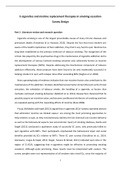E-cigarettes and nicotine replacement therapies in smoking cessation
Survey Design
Part 1- Literature review and research question
Cigarette smoking is one of the largest preventable causes of many chronic diseases and
premature deaths (Farsalinos & Le Houezec 2015). Despite the fact that most smokers are
aware of the health implications of their addiction, they find it very hard to quit. Nicotine has
long been established as the primary reinforcer of tobacco smoking. The recognition of the
critical role played by this psychoactive drug in the maintenance of cigarette addiction led to
the development of various licensed smoking cessation aids collectively known as nicotine
replacement therapies (NRTs). Despite addressing the biochemical component of tobacco
addiction effectively, these products have been found to be only moderately successful in
helping smokers to quit, with relapse rates often exceeding 80% (Hughes et al. 2003).
Now a growing body of evidence indicates that non-nicotine factors also contribute to the
maintenance of the addiction. Smokers identified sensorimotor stimuli (SS) such as the throat
sensation, the exhalation of tobacco smoke, the handling of a cigarette, as factors that
motivate continued smoking behaviour (Addicott et al. 2014). Researchers theorized that SS
possibly acquire an incentive value, and become conditioned reinforcers of smoking overtime
via repeated pairing with the rewarding effects of nicotine (Rose 2006).
Przulj, McRobbie and Hajek (2012) argued that e-cigarettes (ECs)- battery operated devices
that administer nicotine via inhaled vapour- are among the most promising approaches to
help smokers to quit, as they simultaneously address the bio-chemical (via nicotine delivery)
as well as the behavioural aspects (via sensorimotor input) of smoking. Barbeau, Burda and
Siegel (2013) conducted a qualitative study of successful EC users, who previously failed to
quit cigarettes with NRTs. Their participants emphasized the behavioural input and social
benefits provided by ECs relative to NRTs. Three EC user surveys (Farsalinos et al., 2014;
Goniewicz, Lingas & Hajek, 2013; Siegel, Tanwar & Wood, 2011) indicated quit rates in the
region of 31-81%, suggesting that e-cigarettes might be effective in promoting smoking
cessation. Although quite promising, these results must be interpreted with caution. The
survey samples were not representative of all smokers who tried ECs, since the majority of
1
, respondents were dedicated EC users. The reported abstinence rates were not verified
biochemically. They were based solely on self-reports, which might have been biased.
Additionally, only a small number of respondents had been using ECs for more than a year.
Therefore, it is possible that many will relapse, just like many do with NRTs, and the
effectiveness of ECs is overestimated.
In fact, when comparing the efficacy of nicotine e-cigarettes and nicotine patches, Bullen
et al. (2013) found both products to be only modestly effective at aiding smoking cessation.
The reported quit rate was only 7.3% (21 of 289) with the EC, and only 5.8 % (17 of 295) with
the nicotine patch at 6 months. However, Brown et al. (2014) also conducted a cross-sectional
survey of 5863 smokers and found that 20% of the EC users reported abstinence from
cigarettes compared with 10.1% of the NRT users in their sample. The adjusted odds of non-
smoking were 1.63 times higher in e-cigarette users compared with NRT users.
The following questionnaire is aimed at current smokers, who have been contemplating a
quit attempt. It tries to assess their opinions about ECs and NRTs to see how these products
compare against each other in terms of their perceived efficacy and appeal as smoking
cessation aids.
The main research question is: ‘Which method is perceived to be the more effective and
promising approach to smoking cessation among smokers: the use of e-cigarettes or nicotine
replacement therapies?’
Part 2- (Partial) Questionnaire and question types
1. Which of the following aspects of smoking do you think you would personally find the
hardest to cope with after cessation? (multiple-choice question)
a. Biochemical aspect (nicotine withdrawal)
b. Behavioural aspect (habit withdrawal- missing the inhalation/exhalation of smoke,
the throat sensation, the handling of a cigarette etc.)
c. Both aspects equally
d. Neither
2




